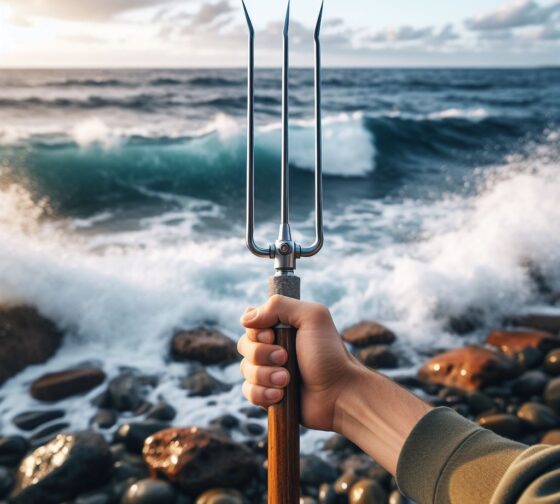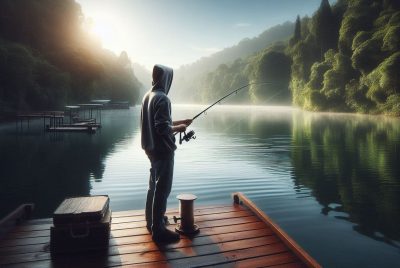Spear Fishing: Embracing Nature, Ensuring Conservation
*We may earn a commission for purchases made using our links. Please see our disclosure to learn more.
Spearfishing Unveiled: An In-Depth Exploration into the Depths
Spearfishing, an ancient art transformed into a captivating sport, immerses enthusiasts in an adventure that intertwines skill, environmental consciousness, and the exhilaration of the catch. My personal journey with spear fishing has been a compelling exploration of the ocean’s depths, merging a profound connection with nature with the pulsating thrill of each successful catch.
This article serves as a comprehensive guide, drawing on my experiences and insights to navigate the nuances of spearfishing, from the intricacies of equipment selection to the joys of underwater camaraderie and the responsibility of preserving our marine environments. Whether you’re a seasoned spear-fisher or a novice eager to plunge into this underwater world, join me on this odyssey into the heart of spearfishing.
The Basics of Spear Fishing
Embarking on a successful spearfishing journey requires a nuanced understanding of essential equipment. At the core is the spear-gun, more than just a tool—it’s an extension of the spear-fisher’s skills and intentions. Choosing the right spear-gun involves considerations such as fish type, experience level, and specific diving conditions, emphasizing the delicate balance between accuracy and power. Each spear-gun model caters to different preferences and skill levels, setting the foundation for a fulfilling spearfishing experience.
Beyond spear-guns, essential diving gear is crucial for comfort and safety underwater. Wetsuits act as a second skin, providing insulation and protection, with considerations for thickness and material. Masks offer a clear view, and selecting the right one is vital for an enjoyable underwater experience. Supplementary gear like fins and snorkels enhances mobility, contributing to a well-prepared and secure spearfishing adventure. Recognizing the importance of both spear-guns and diving gear ensures a balanced and successful foray into the thrilling world of spearfishing.
Safety Precautions
Ensuring a safe and enjoyable spearfishing experience hinges on comprehensive training that covers essential diving techniques, spear-gun usage, and safety measures. This approach not only refines individual skills but also instills a deep sense of responsibility towards oneself and the marine environment, fostering a community of conscientious spear-fishers committed to sustainable practices.
Knowing Your Limits Underwater
In spearfishing, acknowledging and respecting personal physical limits, particularly in breath-holding and diving depth, is paramount for safety. Mastery of breath-holding capacities through gradual training and staying within recognized depth constraints not only ensures personal safety but also contributes to the preservation of the underwater environment. This self-awareness forms the cornerstone of responsible spearfishing, cultivating a culture that prioritizes both individual well-being and environmental sustainability.
Selecting the Right Location for Spear Fishing

Choosing the perfect spearfishing location is crucial for a successful and enjoyable experience. Water visibility, influenced by factors like tides and weather conditions, plays a key role. Strategic timing during optimal conditions enhances the chances of spotting and catching fish. Additionally, selecting locations rich in marine life increases excitement and the likelihood of success. In-depth research into underwater ecosystems allows spear-fishers to align preferences with the characteristics of marine life, ensuring a strategic and rewarding adventure.
Water visibility is paramount in spearfishing, impacted by elements like tides and weather conditions. Understanding these factors allows spear-fishers to plan excursions during optimal visibility, ensuring a more successful and enjoyable experience underwater. Abundance of marine life in selected locations is equally crucial, elevating the thrill and increasing the likelihood of a successful catch. Thorough research empowers spear-fishers to align preferences with the characteristics of marine life, contributing to a well-planned and successful underwater adventure.
Techniques for Successful Spear Fishing
Mastering successful spearfishing requires a blend of patience, keen observation, and a deep understanding of the underwater environment. Spear-fishers must cultivate heightened awareness to interpret subtle underwater cues like currents, shadows, and fish behavior. This symbiotic dance between the spear-fisher and the underwater world hinges on patience and observation, enhancing the chances of precise shots and successful catches.
Patience and Observation: Reading the Underwater Environment
The art of successful spearfishing revolves around reading the underwater environment with finesse. Spear-fishers go beyond recognizing topography, delving into the intricate dance of currents, shadows, and fish behavior. Cultivating these observational skills is transformative, increasing the likelihood of successful catches. Patient waiting and keen observation provide insights into the ebb and flow of marine life, guiding an intuitive process of identifying potential catches. This proficiency not only leads to successful hunts but also promotes ethical and sustainable choices, contributing to marine ecosystem conservation. As spear-fishers refine their patience and observation, they become adept hunters and conscientious stewards of the underwater world, embracing a responsibility to preserve its delicate balance.
Proper Breath-Holding Techniques
Mastering proper breath-holding techniques is pivotal for spearfishing success, allowing for extended dive durations and strategic engagement with the underwater environment. Regular exercises, including diaphragmatic breathing and progressive breath-holding training, not only improve respiratory efficiency but also empower spear-fishers to explore the depths confidently. This investment in honing breath-holding skills transforms the underwater experience, facilitating prolonged interactions with marine life and strategic positioning for successful catches.
Enhancing Lung Capacity
Improving breath-holding capacity through exercises like breath holds and dynamic apnea training is crucial for spearfishing success. Strengthening respiratory muscles expands lung capacity, enabling spear-fishers to spend more time underwater with increased endurance. This commitment to respiratory fitness creates a foundation for a safer, more enjoyable, and successful spearfishing journey, enhancing the ability to navigate challenges effectively and fostering a heightened level of accomplishment in this dynamic aquatic pursuit.
Overcoming Challenges in Spear Fishing
Spearfishing, a thrilling pursuit, requires adept individuals to conquer environmental challenges, particularly navigating ever-changing weather conditions like wind and currents. Adapting to these elements is crucial for success, impacting visibility, marine life behavior, and overall dive dynamics. Spear-fishers’ ability to navigate and leverage these elements contributes to expedition success, deepening their connection with the dynamic nature of spearfishing.
Adapting to Unexpected Situations
Spearfishing demands both skill and adaptability as unexpected situations add unpredictability to each dive. From sudden weather changes to encounters with unexpected marine life or equipment malfunctions, spear-fishers must efficiently handle such scenarios. Flexibility becomes a crucial trait, ensuring a safe and enjoyable experience while injecting excitement and challenge into the pursuit. Spear-fishers embracing the underwater world’s unpredictability navigate challenges effectively, infusing each dive with a sense of adventure and accomplishment.
Spear Fishing Gear Maintenance

Maintaining spearfishing gear’s longevity and reliability in the corrosive saltwater environment requires meticulous care. Cleaning and proper storage after each use are fundamental. The corrosive impact of saltwater, leading to rust and deterioration, necessitates diligent rinsing and disassembling for a thorough cleaning. This commitment preserves gear aesthetics and structural integrity, ensuring a safer and more efficient spearfishing experience.
Cleaning and Storing Equipment: Avoiding Corrosion
Mitigating saltwater’s corrosive effects on spearfishing gear involves proper cleaning and storage practices. Beyond the post-dive rinse, thorough cleaning and storing in a cool, dry environment prevent corrosion, extending gear lifespan. Removing salt residue and contaminants from each piece, coupled with disassembling for storage, minimizes hidden salt deposits and contributes to a reliable and safe underwater experience for spear-fishers.
The Connection with Nature in Spear Fishing
Spearfishing transcends its role as a fishing method, evolving into a transformative journey that deepens the connection with the underwater world. Submerging into transparent waters reveals the captivating marine life and ecosystems, fostering respect and admiration. This sensory experience goes beyond the hunt, instilling in practitioners a love for the underwater environment, emphasizing the importance of environmental preservation.
Spearfishing brings joy and excitement but also a responsibility to protect the underwater environment. Spear-fishers, as stewards of the sea, actively advocate for marine conservation and practice sustainable fishing methods. The profound connection formed during spearfishing instills a deep sense of environmental responsibility, making spear-fishers ambassadors for responsible practices. Their commitment contributes to safeguarding oceans and marine life, ensuring the enduring allure of the underwater world for future generations.
Tips for Beginners
In the thrilling yet challenging initiation into spearfishing, beginners are advised to seek mentorship from experienced spear-fishers. This guidance accelerates learning by offering practical insights, safety protocols, and unwritten rules. The mentorship relationship builds a solid foundation, fostering confidence and competence for a successful spearfishing journey.
Patience is key for beginners in spearfishing. Prioritizing gradual skill development, starting with basics like breath-holding and buoyancy control, ensures a steady and enjoyable progression. As beginners gain confidence, they can explore advanced techniques, fostering a sense of mastery and accomplishment. This step-by-step approach transforms the learning journey into an enjoyable and rewarding experience tailored to individual paces.
Conclusion
In conclusion, spearfishing is not merely a sport; it’s an immersive lifestyle that beckons adventurers to explore the depths of the ocean’s wonders. As we reflect on the challenges conquered and the successes celebrated, let the underwater world leave an indelible mark on your soul. Embrace the unique blend of adventure, skill refinement, and environmental appreciation that spearfishing offers. Through the highs and lows of the journey, always prioritize safety, sustainability, and the joy of connecting with nature. As you navigate the oceans, may your spearfishing experiences be as vast and enriching as the sea itself, creating memories that ripple through the waves of a life well-lived.
FAQs About Spear Fishing
1. Is spearfishing dangerous?
Spearfishing, like any water activity, comes with risks. Proper training, adherence to safety guidelines, and awareness of personal limits significantly reduce the dangers associated with spearfishing.
2. How do I choose the right spear-gun?
Choosing the right spear-gun requires consideration of factors such as skill level, target species, and personal preferences. Consult experienced spear-fishers for advice and consider trying different models to find the perfect fit.
3. What is the best time for spearfishing?
The optimal time for spearfishing varies depending on location and environmental conditions. Generally, early mornings and late afternoons are favorable, but factors like tide and weather should also be taken into account.
4. How can I contribute to marine conservation as a spear-fisher?
Spear-fishers contribute to marine conservation by following ethical practices, adhering to local regulations, and actively participating in beach clean-ups and conservation initiatives. Responsible spearfishing plays a crucial role in preserving marine ecosystems.
5. Can anyone learn spearfishing?
Yes, spearfishing is accessible to anyone willing to learn and dedicate time to practice. Beginners should seek proper instruction, gradually develop their skills, and prioritize safety in their underwater adventures.




